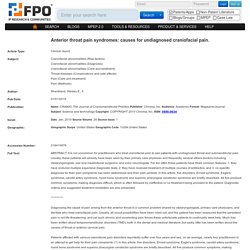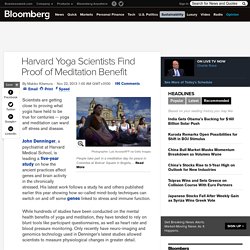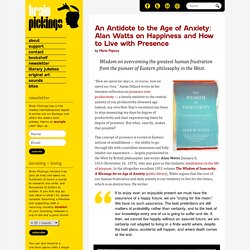

Anterior throat pain syndromes: causes for undiagnosed craniofacial pain. ABSTRACT: It is not uncommon for practitioners who treat craniofacial pain to see patients with undiagnosed throat and submandibular pain.

Usually, these patients will already have been seen by their primary care physician and frequently, several others doctors including otolaryngologists, oral and maxillofacial surgeons, and even neurologists. Far too often these patients have three common features: 1. they have endured multiple expensive diagnostic tests; 2. they have received treatment of multiple courses of antibiotics; and 3. no specific diagnosis for their pain complaints has been determined and their pain persists.
In this article, five disorders, Ernest syndrome, Eagle's syndrome, carotid artery syndrome, hyoid bone syndrome and superior pharyngeal constrictor syndrome are briefly described. All five produce common symptoms, making diagnosis difficult, which is often followed by ineffective or no treatment being provided to the patient.
Ernest Syndrome Eagle's Syndrome. How the Microbes Living in Your Gut Might Be Making You Anxious or Depressed. Photo Credit: Robert Kneschke / Shutterstock.com April 17, 2014 | Like this article?

Join our email list: Stay up to date with the latest headlines via email. Microbes are in the news these days. Circadian rhythms, insulin ac... [Curr Opin Clin Nutr Metab Care. 2014. How To Lucid Dream Part 1/2. How To Lucid Dream part 2/2. How Mindfulness Helps You See What's Missing (And Why You'd Want To) In Basic Mindfulness (the system of Mindfulness I teach) there’s a term called “Gone.”

Gone refers to any moment of partial or complete disappearance that you happen to notice. It’s as simple as that. If you notice a bird stop chirping, if you notice an itch become less itchy, if you notice a car pass by and disappear from view, you could call these events “Gone.” The technique sensitizes you to a fundamental truth: everything is always disappearing.
Impermanence is something you can understand intellectually, as in “this too shall pass.” What I find tragically fascinating about this technique is how frequently students think they’re doing it wrong or don’t believe they can do it at all. Something happened to me the other day that gave me insight into this dilemma, and illuminated the trap our minds so easily get caught in. These minds of ours get stuck – sometimes terribly, terribly stuck. I feel so lucky to have caught the bus of that beautiful moment. Photo Credit: Shutterstock.com. Harvard Yoga Scientists Find Proof of Meditation Benefit. Scientists are getting close to proving what yogis have held to be true for centuries -- yoga and meditation can ward off stress and disease.

John Denninger, a psychiatrist at Harvard Medical School, is leading a five-year study on how the ancient practices affect genes and brain activity in the chronically stressed. His latest work follows a study he and others published earlier this year showing how so-called mind-body techniques can switch on and off some genes linked to stress and immune function. While hundreds of studies have been conducted on the mental health benefits of yoga and meditation, they have tended to rely on blunt tools like participant questionnaires, as well as heart rate and blood pressure monitoring. Only recently have neuro-imaging and genomics technology used in Denninger’s latest studies allowed scientists to measure physiological changes in greater detail. A man practices yoga on the waterfront at Nariman Point in Mumbai. Close Open. The Art of Looking: What 11 Experts Teach Us about Seeing Our Familiar City Block with New Eyes.
By Maria Popova “Attention is an intentional, unapologetic discriminator.

It asks what is relevant right now, and gears us up to notice only that.” “How we spend our days,” Annie Dillard wrote in her timelessly beautiful meditation on presence over productivity, “is, of course, how we spend our lives.” And nowhere do we fail at the art of presence most miserably and most tragically than in urban life — in the city, high on the cult of productivity, where we float past each other, past the buildings and trees and the little boy in the purple pants, past life itself, cut off from the breathing of the world by iPhone earbuds and solipsism. Horowitz begins by pointing our attention to the incompleteness of our experience of what we conveniently call “reality”: Right now, you are missing the vast majority of what is happening around you. The book was her answer to the disconnect, an effort to “attend to that inattention.” The perceptions of infants are remarkable.
An Antidote to the Age of Anxiety: Alan Watts on Happiness and How to Live with Presence. By Maria Popova Wisdom on overcoming the greatest human frustration from the pioneer of Eastern philosophy in the West.

“How we spend our days is, of course, how we spend our lives,” Annie Dillard wrote in her timeless reflection on presence over productivity — a timely antidote to the central anxiety of our productivity-obsessed age. Indeed, my own New Year’s resolution has been to stop measuring my days by degree of productivity and start experiencing them by degree of presence. A Backbend Sequence For Anyone Who Sits All Day. If You Only Do 10 Yoga Poses, Do These.